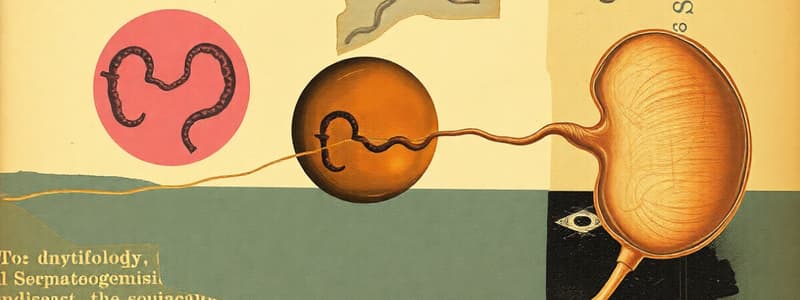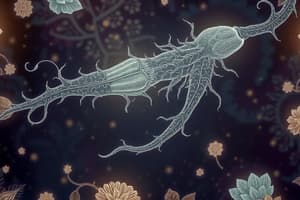Podcast
Questions and Answers
Which of the following statements accurately describes the differences in the timing of completion of meiosis in spermatogenesis and oogenesis?
Which of the following statements accurately describes the differences in the timing of completion of meiosis in spermatogenesis and oogenesis?
- Spermatogenesis completes meiosis continuously throughout life, while oogenesis completes meiosis only in cycles, with one cycle completing per month.
- Spermatogenesis completes meiosis at puberty, while oogenesis completes meiosis only after fertilization. (correct)
- Both spermatogenesis and oogenesis complete meiosis before birth.
- Spermatogenesis completes meiosis during childhood, while oogenesis completes meiosis only after puberty.
If a primary spermatocyte undergoes meiosis I to form two secondary spermatocytes, and then both secondary spermatocytes undergo meiosis II to produce four spermatids, how many sperm cells would be produced from a single spermatogonium that underwent mitosis?
If a primary spermatocyte undergoes meiosis I to form two secondary spermatocytes, and then both secondary spermatocytes undergo meiosis II to produce four spermatids, how many sperm cells would be produced from a single spermatogonium that underwent mitosis?
- 16
- 2
- 4
- 8 (correct)
Which of the following statements accurately describes the role of testosterone in spermatogenesis?
Which of the following statements accurately describes the role of testosterone in spermatogenesis?
- Testosterone stimulates the initial mitotic divisions of spermatogonia, leading to the formation of primary spermatocytes.
- Testosterone directly influences the meiotic divisions of primary spermatocytes, leading to the formation of secondary spermatocytes.
- Testosterone promotes the formation of the acrosome but does not directly influence the development of the flagellum.
- Testosterone is essential for the conversion of spermatids into spermatozoa, promoting the development of the flagellum and acrosome. (correct)
Which of the following is NOT a key difference between spermatogenesis and oogenesis?
Which of the following is NOT a key difference between spermatogenesis and oogenesis?
Which of the following correctly describes the stage of oogenesis where meiosis is arrested until fertilization?
Which of the following correctly describes the stage of oogenesis where meiosis is arrested until fertilization?
Which of the following statements accurately describes the role of FSH in oogenesis?
Which of the following statements accurately describes the role of FSH in oogenesis?
Why is it important for oogenesis to produce only one functional gamete (the ovum) and three polar bodies, unlike the equal production of four functional gametes in spermatogenesis?
Why is it important for oogenesis to produce only one functional gamete (the ovum) and three polar bodies, unlike the equal production of four functional gametes in spermatogenesis?
Which of the following factors plays a DIRECT role in regulating the timing and progression of oogenesis?
Which of the following factors plays a DIRECT role in regulating the timing and progression of oogenesis?
During which stage of oogenesis is a secondary oocyte released from the ovary during ovulation?
During which stage of oogenesis is a secondary oocyte released from the ovary during ovulation?
If a mutation occurs during the mitotic division of spermatogonia, how would this affect the resulting sperm cells?
If a mutation occurs during the mitotic division of spermatogonia, how would this affect the resulting sperm cells?
Flashcards
Embryology
Embryology
The study of organism development from fertilization to birth.
Cleavage
Cleavage
Rapid cell division without growth during early development.
Gastrulation
Gastrulation
Process where cells form three primary germ layers: ectoderm, mesoderm, endoderm.
Neurulation
Neurulation
Signup and view all the flashcards
Spermatogenesis
Spermatogenesis
Signup and view all the flashcards
Oogenesis
Oogenesis
Signup and view all the flashcards
Primary Spermatocyte
Primary Spermatocyte
Signup and view all the flashcards
Secondary Oocyte
Secondary Oocyte
Signup and view all the flashcards
Polar Body
Polar Body
Signup and view all the flashcards
Factors Influencing Development
Factors Influencing Development
Signup and view all the flashcards
Study Notes
Embryology
- Embryology is the study of the development of an organism from the fertilized egg to birth.
- It encompasses the processes of cell division, differentiation, and morphogenesis.
- Early embryonic development involves cleavage, gastrulation, and neurulation.
- Cleavage is rapid cell division without significant growth.
- Gastrulation is a process where cells rearrange to form three primary germ layers: ectoderm, mesoderm, and endoderm.
- Neurulation is the development of the nervous system.
- Different organisms exhibit variations in developmental processes, reflecting evolutionary relationships.
- Factors influencing embryonic development include genetic factors, environmental factors, and nutrition.
Spermatogenesis
- Spermatogenesis is the process of male gamete (sperm) production.
- It occurs in the seminiferous tubules of the testes.
- The process involves meiosis, which reduces the chromosome number by half, and differentiation.
- Spermatogonia undergo mitosis to produce spermatocytes.
- Primary spermatocytes undergo meiosis I to form secondary spermatocytes.
- Secondary spermatocytes undergo meiosis II to produce spermatids.
- Spermatids mature into spermatozoa (sperm).
- Spermatogenesis is a continuous process.
- Factors such as hormones (testosterone), temperature, and nutrition influence the process.
Oogenesis
- Oogenesis is the process of female gamete (ovum) production.
- It occurs in the ovaries.
- Oogenesis begins during fetal development.
- Oogonia divide by mitosis to produce primary oocytes.
- Primary oocytes are arrested in prophase I of meiosis.
- At puberty, primary oocytes resume meiosis.
- Meiosis I produces a secondary oocyte and a polar body.
- The secondary oocyte is arrested in metaphase II.
- Fertilization triggers completion of meiosis II, producing an ovum and a second polar body.
- Oogenesis is not a continuous process; it occurs in cycles.
- Hormones such as FSH and LH play key roles in regulating the process.
- The process is cyclical and is influenced by hormonal cycles.
- During each cycle, a limited number of primary oocytes are recruited.
Studying That Suits You
Use AI to generate personalized quizzes and flashcards to suit your learning preferences.


